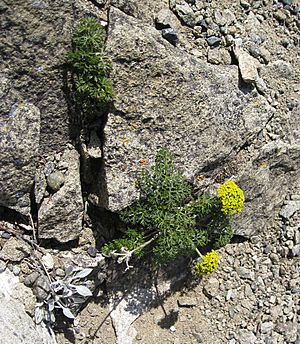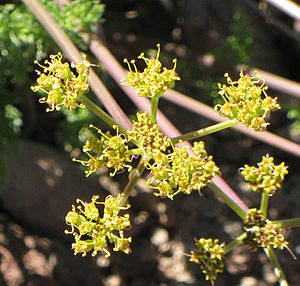Aromatic spring-parsley facts for kids
Quick facts for kids Cymopterus terebinthinus |
|
|---|---|
 |
|
| Conservation status | |
| Scientific classification | |
| Kingdom: | |
| Phylum: | |
| Class: | |
| Order: | |
| Family: | |
| Genus: |
Cymopterus
|
| Species: |
C. terebinthinus
|
| Binomial name | |
| Cymopterus terebinthinus Cronquist
|
|
Cymopterus terebinthinus is a plant that lives for many years, belonging to the carrot family. Its leaves look a lot like parsley. This plant grows in the dry, open lands of the Great Basin in the western United States. People also call it Aromatic spring-parsley, northern Indian parsnip, or turpentine cymopterus.
Contents
Understanding the Plant's Name
The name Cymopterus comes from words meaning "wavy ring." This describes the shape of the plant's fruit. The second part, terebinthinus, means "like turpentine." This refers to the strong, unique smell of the plant's natural oils.
What Does This Plant Look Like?
How It Grows
This plant is a perennial, meaning it lives for more than two years. It grows low to the ground, usually from 0.15 to 0.6 meters (about 6 inches to 2 feet) tall. It spreads out from a strong, woody base.
Leaves and Stems
The leaves of Cymopterus terebinthinus can be anywhere from 1.3 to 20 centimeters (about 0.5 to 8 inches) long. They have an oval shape overall. However, each leaf is divided into many small parts, making them look like parsley leaves. If you crush the leaves, they release a very strong, pleasant smell. This scent is what the name "terebinthinus" refers to.
Flowers and Fruit
The plant produces flower stalks called peduncles. Each stalk has between 3 and 24 branches, and these branches are about 1.3 to 7.6 centimeters (0.5 to 3 inches) long. At the end of these branches are tiny yellow flowers, each with five petals.
Where Does This Plant Live?
Cymopterus terebinthinus prefers dry, sandy, or rocky hillsides. You often find it growing near rocks. It lives in areas between 1,500 and 2,700 meters (about 5,000 to 9,000 feet) high. These areas include sagebrush steppe and montane plant communities in the Great Basin. You can spot this plant in places like the Toiyabe Range and the Deep Creek Mountains.
How It Interacts with Nature
This plant plays an important role in its environment. It is a host plant for the Papilio indra butterfly. This means the butterfly lays its eggs on the plant, and the caterpillars eat its leaves.
Some Native American tribes from the Plateau region traditionally used the roots of this plant. They would chew the roots to help with common colds and to soothe sores.



